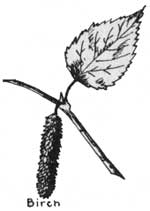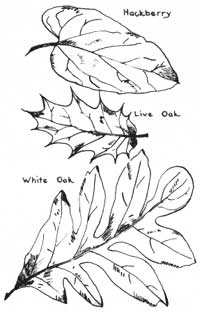|
ZION
Plants of Zion National Park |

|
Zion-Bryce Museum Bulletin
Number 1
PLANTS OF ZION NATIONAL PARK
Families of Plants
(continued)
WILLOW FAMILY (SALICACEAE)
ASPEN, Populus tremuloides aurea. A very common tree in moist places above 6500 feet altitude; sometimes found down to 5600 in shady nooks. Several fair-sized groves on Horse Pasture Plateau, and small groups around a few springs on East Rim. Their beautiful white trunks and small leaves sometimes cause visitors to mistake them for birches. In autumn they are a blaze of color — orange, lemon yellow, and red.
COTTONWOOD, Populus fremontii pubescens. Common along streams and in moist places in Lower and Upper Sonoran Zones; the largest and most common tree in Zion Canyon.
NARROW-LEAF COTTONWOOD, Populus angustifolia. Very common north and east of the park, but thus far known from only two places inside the boundary: in the Narrows at extreme northeast boundary, and at a spring near the top of Cable Mountain.
Ten kinds of WILLOWS have been recorded for Zion, but the slight differences between them are of little interest to most of the visitors. Four species along the Virgin River grow to be trees: BLACK WILLOW, Salix lasiandra caudata; DUDLEY WILLOW, Salix gooddingii; RED WILLOW, Salix laevigata; and WHITE WILLOW, Salix lasiolepis. The willow thickets so common along the streams are chiefly the very narrow-leaved SANDBAR WILLOW, Salix exigua. Other shrub species, usually found in cool canyons or on the plateaus are: Salix lutea, Salix bebbiana, Salix geyeriana, Salix subcoerulea, and Salix scouleriana.

BIRCH FAMILY (BETULACEAE)
RED BIRCH, Betula fontinalis. A shrub or small tree, sometimes up to one foot in diameter, with smooth reddish-brown bark. Common near springs and brooks, Upper Sonoran and Transition Zones, as at Weeping Rock, Emerald Pools, Grotto, West Rim ranger station, etc.
BEECH FAMILY (FAGACEAE)
A family of trees and shrubs represented in our area only by the oaks.
ROCKY MOUNTAIN WHITE OAK, Quercus utahensis. The most common oak in the park, and the only one that regularly attains tree size. It is usually the dominant shrub in the chaparral that occurs nearly everywhere on the plateaus, and is also common in the higher and cooler Upper Sonoran Zone chaparral areas; it often forms dense thickets in both situations. Where there is sufficient moisture it grows to be a small tree, seldom over 30 feet high and 1 foot in diameter, This oak sheds its leaves, as does also the SCRUB OAK, Quercus gambelii, which so nearly resembles utahensis as to puzzle even an expert. The scrub oak never grows to tree size.
The two LIVE OAKS (evergreen shrubs) of this area are also difficult to distinguish, but both are easily separated from the white oaks by their prickly leaves. Quercus undulata is the most common of the two, being found in nearly all of the pygmy forest belt, and even up into the Transition Zone in places, as on the top of Lady Mountain. Its small acorn, with a hemispherical cup, distinguishes it from Quercus dumosa turbinella, which has a slightly larger acorn with a top-shaped cup. This latter species is not very common, being confined to Coalpits Wash and a few other Upper Sonoran talus slopes.

ELM FAMILY (ULMACEE)
The HACKBERRY, Celtis reticulata, is the only representative of this family in our region. It is a shrub or small tree, easily recognized by its "lop-sided" leaves which have a rough surface almost like sandpaper. This characteristic, combined with its rough bark and stiff branches, give the whole tree an appearance of having been rubbed the wrong way. Flickers and other birds like to feed on the dark red berries, which ripen in September. Found on the talus slopes in Upper Sonoran Zone.
HEMP FAMILY (CANNABINACEAE)
AMERICAN HOP, Humulus americanus. Wild hop vines grow in a few places in Zion Canyon, Shunes Creek, and North Creek; especially noticeable on the Narrows Trail and at Weeping Rock.
MULBERRY FAMILY (MORACEAE)
This family is not native to our area, but is represented in the park by two species that escaped from cultivation in Zion Canyon, which was farmed until set aside for park use in 1909 (lower portion was not added to park until 1930). They are the MULBERRY, Morus alba, and the FIG, Ficus carica. Both are very uncommon and will eventually be eliminated.
NETTLE FAMILY (UTERICACEAE)
Most visitors might never discover the existence of this plant family within the park, for it is represented only by Parietaria obtusa, a small inconspicuous nettle-like plant that has been collected in Coalpits Wash. It differs from a true nettle in having alternate leaves without stinging hairs.
MISTLETOE FAMILY (LORANTHACEAE)
Members of this family are all evergreen plants that are parasitic on trees or shrubs. Unlike the kind so popular as Christmas decorations, our four species are nearly leafless, and are a sickly yellowish-brown in color. They are common on branches of cone-bearing trees, causing swelling and often dense growth of branches (witches-brooms). The four kinds reported to date are: Phoradendron juniperinum, parasitic on Junipers; Razoumofskya divaricata, on pinyon pines; Razoumofskya cryptopoda, on yellow pines and pinyons; and Razoumofskya douglasii, on douglas fir.
SANDALWOOD FAMILY (SANTALACEAE)
Our only representative of this family is Comandra pallida, a perennial herb 6 to 10 inches tall, with alternate leaves and small greenish flowers; found growing in sandy places in both Sonoran Zones, but not commonly so.
BUCKWHEAT FAMILY (POLYGONACEAE)
A few of the conspicuous flowers of dry areas belong to this family, although it also includes several inconspicuous and weed-like forms. Ours are mostly herbs with jointed stems, and numerous small flowers in umbrella or spike shaped clusters. The one seeded fruit is three or four angled, and winged.
There are ten kinds of WILD BUCKWHEAT, or ERIOGONUM, in the park; the most attractive flowers of the buckwheat family being included among them.
Eriogonum deflexum occurs rarely in the dry exposed areas of both Sonoran Zones. The tiny white or rose-colored flowers form a loose "umbrella" at the top of a leafless stem which rises about one foot above a rosette of round white wooly leaves.
Eriogonum watsoni has the same distribution. The single, almost leafless stalk grows about two feet high, dividing and redividing into hundreds of hair-thin branchlets bearing tiny flower clusters, bright red in the bud, turning pinkish white when mature. The basal leaves are white wooly beneath. Eriogonum cernum is an other branching species, with much the same distribution. The branches are covered with silky hairs, and the papery white flowers, green veined, are slightly larger than in watsoni. Basal leaves are similar.
Eriogonum heracleoides has stalks 1 to 2 feet high with narrow slightly hairy leaves at the base and in a whorl near the middle; at the top a compact head of a few yellow flowers, 1/4 inch across. It grows in the Transition Zone.
Eriogonum inflatum, called "bottle stopper" is easily distinguished by its leafless inflated stems, from 1 to 2 feet high, branching profusely. It has numerous tiny yellow flowers. Fairly common in Upper Sonoran Zone.
Eriogonum racemosum is a tall branching herb having small pink and white flowers in elongated terminal clusters. The leaves, white wooly beneath, are chiefly basal, with a few at the Joints. It occurs throughout the park.
Eriogonum stellatum has many yellow flowers in compact heads which form a loose umbrella at the top of a scantily branching stem about 1 foot high. Common throughout the park. Eriogonum jamesii flavescens is somewhat similar, but smaller with hairy stems and leaves white wooly beneath. It occurs in the cooler areas of the park.
Eriogonum divergens is distinguished from other eriogonums by the crinkly-edged pale green leaves, wooly beneath, growing along the full length of the crooked stem. Numerous tiny yellow flowers grow on the widely divergent branchlets.
Eriogonum elatum has small greenish flowers in flat clusters sparsely arranged along the upper part of the tall straight stalk. The stem and leaves, chiefly basal, are slightly hairy. Found on Horse Pasture Plateau.
Two species of DOCK occur in Zion: CURLED DOCK, Rumex crispus, a coarse weedy plant having dark green wavy-margined leaves; and WILLOW LEAVED DOCK, Rumex mexicanus, with pale green flat-margined leaves. Both are roadside weeds having small reddish-green flowers thickly clustered near the top of the stalk, maturing into conspicuous red winged seeds.
The KNOTWEEDS are grass-like "weeds" with inconspicuous greenish flowers clustered in the leaf axils. They are common in waste places throughout the park, two kinds being known: Polygonum buxiforme, prostrate, with rather wide leaves; and Polygonum ramosissimum, erect, with narrow leaves.
CORNBIND, Bilderdykia convolvulus, is a vine with arrow-shaped leaves, growing in waste places at the lower end of Zion Canyon.